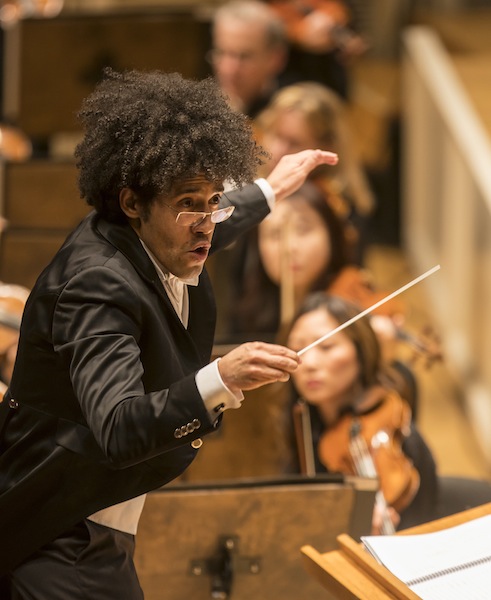Venezuelan conductor makes an admirable downtown debut with CSO
Rafael Payare made his Chicago Symphony Orchestra podium debut in 2015 at Ravinia. The young Venezuelan seemingly impressed the CSO powers-that-be enough to earn an immediate downtown subscription engagement—a feat almost unprecedented for a young conductor.
Payare’s admirable Orchestra Hall debut Thursday night provided evidence of a young and charismatic maestro who at his best can whip up considerable excitement–somewhat in the vein of his compatriot Gustavo Dudamel, also a product of their nation’s El Sistema program. And yet while Payare has been making the rounds of the world’s leading orchestras there were also signs that the slender, bushy-topped maestro could use some experience and seasoning.
Like American orchestras everywhere this season, the CSO is marking the centennial birthday year of Leonard Bernstein. The Symphonic Suite from On the Waterfront was performed last October and Payare opened his program with the Symphonic Dances from West Side Story.
This souped-up orchestral suite, adapted from Bernstein’s hit Broadway musical of doomed teen love among street gangs in 1950s New York–still the greatest work in the genre–is almost failsafe in performance. The best performances should make you want to go directly home, load the DVD and watch West Side Story all over again.
The seismic performance served up by the CSO under Payare’s direction certainly did that. The high-stepping dance episodes were given full-tilt dynamism, Payare drawing combustible playing from the brass and Latin percussion. (The CSO players’ finger-snapping was on the money though the “Mambo!” shouts were a bit inhibited.)
Apart from the thrilling sonic and rhythmic fury, Payare also impressed in the more restrained sections. He coaxed a lovely and shimmering yet not over the top “Somewhere” and elicited playing of piquant delicacy in the cha-cha take on “Maria.” The conductor was also skillful in making this confection organic, keeping firm focus in transitional sequences and avoiding the feeling of a greatest-hits collection.
A wavery flute apart, there was terrific playing from the CSO across all sections, with the stratospheric solo trumpet nailed in the “Dance at the Gym.” The orchestra looked happy to be back on the job and sounded rested and newly energized after their long Christmas break.
The evening closed with Bartok’s Concerto for Orchestra. As in the Bernstein, Payare was a confident and engaging figure on the podium, yet here the musical rewards proved more mixed.
While there were inspired moments, it wasn’t always clear that Payare had an overriding vision of this much-played work. The opening pages of the Introduzione were lacking in mystery and the Elegia sounded similarly undercharacterized, missing the unsettling nocturnal atmosphere. There was a literal quality to Payare’s direction, which was serviceable bar to bar but too often failed to convey the larger picture—notably the score’s sheer weirdness and grandeur. The conductor was most effective when the volume grew louder.
The final two movements went better with a full-blooded lampooning of Shostakovich in the Intermezzo and dazzling ensemble virtuosity in the headlong tumult of the finale. Of course, the orchestra has had this music in its DNA for over a half-century, from the Fritz Reiner and Georg Solti eras on, and delivered sufficient verve and individuality on their own, with notably witty pairs of clarinets and bassoons in the second movement.
The centerpiece of the evening was Mozart’s Bassoon Concerto featuring the orchestra’s principal Keith Buncke in his first solo outing with the CSO.
The Portland native has been a welcome addition to the woodwind section since joining the CSO in 2015 at age 21. In addition to his astoundingly seamless technique, his fresh and individual playing has brought a welcome personality to an often low-profile position.
His Mozart performance was as technically assured as one would expect, Buncke sailing through the two-octave leaps and rapid figurations with nimble agility and unruffled poise.
Yet, ultimately this concerto debut came as something of a disappointment. Buncke’s playing felt too cautious and his lightish tone didn’t project well, even to the front of the lower balcony. Most surprising, there was a pallid, even bland quality to his solo playing. Buncke’s own quirky cadenzas showed more personality and a degree more playfulness, though they went on too long, especially in the slow movement.
Buncke floated a graceful solo line in the Andante but the expression stayed largely on the surface. In 2014 David McGill, Buncke’s predecessor, explored a depth and eloquence in this movement that one didn’t even know existed.
Keith Buncke is such a gifted musician it’s sometimes easy to forget that he’s still just 24 years old. No doubt his future performances of this cornerstone concerto will gain in expression and richness with the experience that the years will bring.
The program will be repeated 8 p.m. Saturday. cso.org; 312-294-3000.
Posted in Performances






